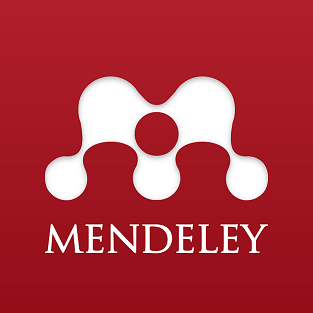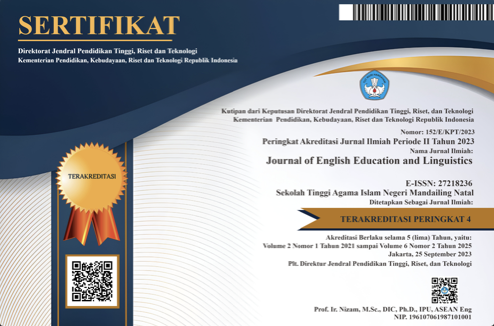BACKCHANNEL AS FORMATIVE ASSESSMENT IN ENGLISH CLASSROOM; THE STUDENTS’ PERSPECTIVE
DOI:
https://doi.org/10.56874/jeel.v3i1.781Keywords:
Backchannel, Formative assessment, Students' perspectiveAbstract
Dealing with assessment, formative is one way of assessing students' performance during classroom activities. The latest curriculum in Indonesia, curriculum 2013, demands teachers to assess students not just at the end of learning. The objectives of the study are to find out students’ responses on the implementation of backchannel as formative assessment implemented in English classroom, to identify areas of students learning activity are influenced by backchannel implemented in English classroom, and to describe the difficulties faced by the students in the implementation of backchannel in their English classroom. The approach of this study was qualitative design. The subjects are the eighth-grade students of SMP N 6 Semarang. The results showed that the backchannel method was applied in eighth D class is success. The backchannel method as a formative assessment gets positive responses from students. The students are mostly affected in the area of backchannel in which they can improve their skills in English with a high understanding of the process. Some students can improve their speaking skills because they receive a lot of new vocabulary and this method makes them more active. The challenges that they faced are about time, understanding and internet signal.
References
Adams, D., & Hamm, M. (2010).Demystify math, science, and technology: creativity, innovation, and problem-solving. R&L Education.
Amalia, R. (2018).Students' perception of Online Assessment use in Schoology in EFL Classrooms(Doctoral dissertation, UIN Sunan Ampel Surabaya).
Biggs, J. (2003). Teaching international students.Teaching for quality learning at university, 120-139.
Black, P., & Wiliam, D. (2009). Developing the theory of formative assessment.Educational Assessment, Evaluation and Accountability (formerly: Journal of Personnel Evaluation in Education),21(1), 5.
Boston, C. (2002). The concept of formative assessment.Practical Assessment, Research, and Evaluation,8(1), 9.
Brown, D. H. (2004). Language Assessment: Principles and Classroom Practices.
Candrlic, S., Katić, M. A., & Dlab, M. H. (2014, May). Online vs. paper-based testing: A comparison of test results. In2014 37th International Convention on Information and Communication Technology, Electronics and Microelectronics (MIPRO)(pp. 657-662). IEEE.
Chen, Y., & Hoshower, L. B. (2003). Student evaluation of teaching effectiveness: An assessment of student perception and motivation.Assessment & evaluationin higher education,28(1), 71-88.
Clason, D. L., & Dormody, T. J. (1994). Analyzing data measured by individual Likert-type items.Journal of agricultural education,35(4), 4.
Cohen, L., Manion, L., & Morrison, K. (2013).Research methods in education. routledge.
Cronin, J. J. (2011). The Classroom as a Virtual Community: An Experience with Student Backchannel Discourse.Business Education Innovation Journal,3(2).
Fatmawati, Tri Mei. 2019. English Teachers‟ Difficulties on the Use of Authentic Assessmentin SMP N 6 Semarang in Academic Year 2018/2019. Final Project, English Study Program, Faculty of Language and Arts Education, University of PGRI Semarang.
Fautley, M., & Savage, J. (2008).Assessment for learning and teaching in secondary schools. Learning Matters.
Gay, L. R., Mills, G. E., & Airasian, P. W. (2009).Educational research: Competencies for analysis and applications. Merrill/Pearson.
Hidayati, N. (2016).The Authenticity of English Language Assessment For The Twelfth Grade Students Of SMK Negeri 4 Surakarta In Academic Year Of 2015/2016 (Doctoral dissertation, Universitas Muhammadiyah Surakarta).
Jamieson, S. (2004). Likert scales: How to (ab) use them?.Medical education,38(12), 1217-1218.
Kothari, C. R. (2004).Research methodology: Methods and techniques. New Age International.
Lambert, D., & Lines, D. (2013).Understanding assessment: Purposes, perceptions, practice. Routledge.
LuoShaoqian. (2003). The Research of English Classroom Teaching. Beijing: Foreign Language Teaching and Research Press.
Maulidhawati, Rini. 2019. Washback Effect of The Authentic Assessment in English Class of The Eighth Grade in SMP N 6 Semarang. Final Project, English Study Program, Faculty of Language and Arts Education, University of PGRI Semarang.
Nurgiyantoro, B. (2001).Penilaian dalam pengajaran bahasa dan sastra. BPFE-Yogyakarta.Perera-Diltz, D. M. (2009). Assessment purposes. In E. Bradford (Ed.), ACA encyclopedia of counseling (pp.38–39). Alexandria, VA: American Counseling Association
Popham, W. J. (2006, September). Defining and enhancing formative assessment. InAnnual Large-Scale Assessment Conference, Council of Chief State School Officers, San Francisco, CA.
Popham, W. J. (2008). Transformative Assessment: Association for Supervision and Curriculum Development. 1703 North Beauregard Street, Alexandria, VA 22311-1714.
Prastikawati, E. F. (2018). EFL Learners‟ Responses on the Use of Performance-based Assessment.Lensa: Kajian Kebahasaan, Kesusastraan, dan Budaya,8(1), 75-86.
Ramsey, B., &Duffy, A. (2016). Formative assessment in the classroom: Findingsfrom three districts.Michael and Susan Dell Foundation and Education,1.Wiyaka, et al. 2016. Alternative Assessments for Reading in Senior High Schools: A Guide for Classroom Practices. CELT Journal, 16 (1), 20-6.
Downloads
Published
Issue
Section
License
All articles published in the Journal of English Education and Linguistics are licensed under a Creative Commons Attribution-ShareAlike 4.0 International (CC BY-SA) license. This means anyone is free to copy, transform, or redistribute articles for any lawful purpose in any medium, provided they give appropriate attribution to the original author(s) and Journal of English Education and Linguistics, link to the license, indicate if changes were made, and redistribute any derivative work under the same license.
Copyright on articles is retained by the respective author(s) without restrictions. A non-exclusive license is granted to the Journal of English Education and Linguistics to publish the article and identify itself as its original publisher, along with the commercial right to include the article in a hardcopy issue for sale to libraries and individuals.
Although the conditions of the Creative Commons Attribution-ShareAlike 4.0 International (CC BY-SA) license do not apply to authors (as the copyright holder of your article, you have no restrictions on your rights), by submitting to the Journal of English Education and Linguistics, authors recognize the rights of readers and must grant any third party the right to use their articles to the extent provided by the license.

This work is licensed under a Creative Commons Attribution-ShareAlike 4.0 International License.








